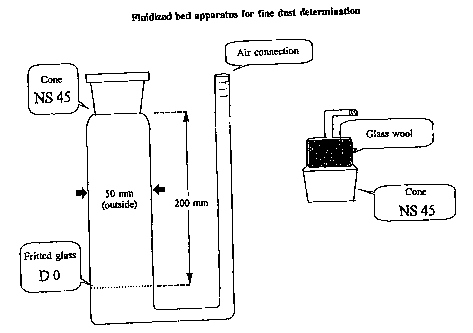Some of the information on this Web page has been provided by external sources. The Government of Canada is not responsible for the accuracy, reliability or currency of the information supplied by external sources. Users wishing to rely upon this information should consult directly with the source of the information. Content provided by external sources is not subject to official languages, privacy and accessibility requirements.
Any discrepancies in the text and image of the Claims and Abstract are due to differing posting times. Text of the Claims and Abstract are posted:
| (12) Patent: | (11) CA 2219604 |
|---|---|
| (54) English Title: | PROCESS FOR IMPROVING THE ABRASION RESISTANCE OF ZEOLITE MOULDED BODIES |
| (54) French Title: | METHODE POUR AMELIORER LA RESISTANCE DE CORPS MOULES A BASE DE ZEOLITE CONTRE L'USURE |
| Status: | Expired and beyond the Period of Reversal |
| (51) International Patent Classification (IPC): |
|
|---|---|
| (72) Inventors : |
|
| (73) Owners : |
|
| (71) Applicants : |
|
| (74) Agent: | MARKS & CLERK |
| (74) Associate agent: | |
| (45) Issued: | 2007-01-09 |
| (22) Filed Date: | 1997-10-29 |
| (41) Open to Public Inspection: | 1998-04-30 |
| Examination requested: | 2002-10-29 |
| Availability of licence: | N/A |
| Dedicated to the Public: | N/A |
| (25) Language of filing: | English |
| Patent Cooperation Treaty (PCT): | No |
|---|
| (30) Application Priority Data: | ||||||
|---|---|---|---|---|---|---|
|
The abrasion resistance of zeolite moulded bodies is improved by spraying the zeolite moulded bodies with an aqueous silica sol solution and then optionally drying and calcining them.
La résistance à l'usure de corps moulés à base de zéolithe est améliorée en pulvérisant les corps moulés à base de zéolithe d'une sol de silice aqueuse, puis éventuellement en les séchant et en les calcinant.
Note: Claims are shown in the official language in which they were submitted.
Note: Descriptions are shown in the official language in which they were submitted.

2024-08-01:As part of the Next Generation Patents (NGP) transition, the Canadian Patents Database (CPD) now contains a more detailed Event History, which replicates the Event Log of our new back-office solution.
Please note that "Inactive:" events refers to events no longer in use in our new back-office solution.
For a clearer understanding of the status of the application/patent presented on this page, the site Disclaimer , as well as the definitions for Patent , Event History , Maintenance Fee and Payment History should be consulted.
| Description | Date |
|---|---|
| Time Limit for Reversal Expired | 2012-10-29 |
| Letter Sent | 2011-10-31 |
| Grant by Issuance | 2007-01-09 |
| Inactive: Cover page published | 2007-01-08 |
| Inactive: Final fee received | 2006-10-04 |
| Pre-grant | 2006-10-04 |
| Notice of Allowance is Issued | 2006-04-04 |
| Letter Sent | 2006-04-04 |
| Notice of Allowance is Issued | 2006-04-04 |
| Inactive: Approved for allowance (AFA) | 2006-03-20 |
| Inactive: IPC from MCD | 2006-03-12 |
| Inactive: IPC from MCD | 2006-03-12 |
| Amendment Received - Voluntary Amendment | 2005-10-07 |
| Inactive: S.29 Rules - Examiner requisition | 2005-04-15 |
| Inactive: S.30(2) Rules - Examiner requisition | 2005-04-15 |
| Letter Sent | 2002-12-09 |
| Letter Sent | 2002-12-05 |
| Request for Examination Requirements Determined Compliant | 2002-10-29 |
| All Requirements for Examination Determined Compliant | 2002-10-29 |
| Inactive: Single transfer | 2002-10-29 |
| Request for Examination Received | 2002-10-29 |
| Letter Sent | 2002-01-11 |
| Letter Sent | 1999-06-22 |
| Inactive: Multiple transfers | 1999-04-30 |
| Application Published (Open to Public Inspection) | 1998-04-30 |
| Inactive: IPC assigned | 1998-02-12 |
| Classification Modified | 1998-02-12 |
| Inactive: IPC assigned | 1998-02-12 |
| Inactive: First IPC assigned | 1998-02-12 |
| Inactive: IPC assigned | 1998-02-12 |
| Inactive: IPC assigned | 1998-02-12 |
| Inactive: Filing certificate - No RFE (English) | 1998-01-23 |
| Letter Sent | 1998-01-23 |
| Application Received - Regular National | 1998-01-22 |
There is no abandonment history.
The last payment was received on 2006-10-06
Note : If the full payment has not been received on or before the date indicated, a further fee may be required which may be one of the following
Patent fees are adjusted on the 1st of January every year. The amounts above are the current amounts if received by December 31 of the current year.
Please refer to the CIPO
Patent Fees
web page to see all current fee amounts.
Note: Records showing the ownership history in alphabetical order.
| Current Owners on Record |
|---|
| GRACE GMBH & CO. KG |
| Past Owners on Record |
|---|
| ECKEHART ROLAND |
| ELKE KOSSEL |
| FRANK HEINDL |
| OLIVER FEUER |